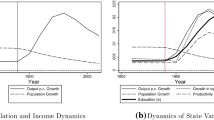Abstract
What Makes a Country Socially Capable of Catching Up? —In this study, the authors test whether social capability promotes catching up, the hypothesis that there is technological spillover from leaders to followers. A simple model that captures the hypothesized interaction is presented and tested on an extended sample of countries. The stock of human capital and the degree of integration into the world economy are used to measure social capability. Both measures are important in determining the degree to which the catching-up potential is realized. The authors also find an independent effect of increased trade intensity and trade regime on productivity growth.
Zusammenfassung
Was setzt ein Land gesellschaftlich in den Stand, wirtschaftlich aufzuholen? —In diesem Aufsatz untersuchen die Autoren, ob gesellschaftliche Faktoren das Aufholen fördern, also die Hypothese, daß es unter den Ländern einen technologischen Spillover von den Vorreitern zu den Nachzüglern gibt. Ein einfaches Modell, das diese hypothetische Beziehung enthält, wird vorgestellt und für eine Reihe von Ländern getestet. Die gesellschaftliche Fähigkeit wird durch den Bestand an Humankapital und den Grad der Integration in die Weltwirtschaft gemessen. Beide Maße sind wichtig, um den Grad zu bestimmen, bis zu dem das Aufholpotential realisiert worden ist. Die Autoren ermitteln auch eine unabhängige Wirkung der verstärkten Handelsintensität und des Handelsregimes auf das Produktivitätswachstum.
Similar content being viewed by others
References
Abramovitz, Moses, “Catching Up, Forging Ahead, and Falling Behind”.The Journal of Economic History, Vol. 46, 1986, pp. 385–406.
Alam, M. Shahid, “Convergence in Developed Countries: An Empirical Investigation”.Weltwirtschaftliches Archiv, Vol. 128, 1992, pp. 189–201.
Barro, Robert J., “Economic Growth in a Cross Section of Countries”.The Quarterly Journal of Economics, Vol. 106, 1991, pp. 407–443.
—,Xavier Sala-i-Martin, “Convergence”.Journal of Political Economy, Vol. 100, 1992, pp. 223–251.
Baumol, William J., “Productivity Growth, Convergence, and Welfare: What the Long-Run Data Show”.The American Economic Review, Vol. 76, 1986, pp. 1072–1085.
—,Edward N. Wolff, “Productivity Growth, Convergence, and Welfare: Reply”.The American Economic Review, Vol. 78, 1988, pp. 1155–1159.
Dalham, Carl J., Bruce Ross-Larson, Larry E. Westphal, “Managing Technological Development: Lessons from the Newly Industrialized Countries”.World Development, Vol. 15, 1987, pp. 759–775.
DeLong, J. Bradford, “Productivity Growth, Convergence, and Welfare: Comment”.The American Economic Review, Vol. 78, 1988, pp. 1138–1154.
Dollar, David, Edward N. Wolff, “Convergence of Industry Labor Productivity among Advanced Economies, 1963–82”.The Review of Economics and Statistics, Vol. 70, 1988, pp. 549–558.
Dowrick, Steve, “Sectoral Change, Catching Up and Slowing Down: OECD Post-War Economic Growth Revisited”.Economics Letters, Vol. 31, 1989, pp. 331–335.
—, “Technological Catch Up and Diverging Incomes: Patterns of Economic Growth 1960–88”.The Economic Journal, Vol. 102, 1992, pp. 600–610.
—,Norman Gemmell, “Industrialisation, Catching Up and Economic Growth: A Comparative Study Across the World’s Capitalist Economies”.The Economic Journal, Vol. 101, 1991, pp. 263–275.
—,Duc-Tho Nguyen, “OECD Comparative Economic Growth 1950–85: Catch Up and Convergence”.The American Economic Review, Vol.79, 1989, pp. 1010–1030.
Easterlin, Richard A., “Why Isn’t the Whole World Developed?”.The Journal of Economic History, Vol. 41, 1981, pp. 1–19.
Edwards, Sebastian, “Trade Orientation, Distortions and Growth in Developing Countries”.Journal of Development Economics, Vol. 39, 1992, pp. 31–57.
—, “Openness, Trade Liberalization, and Growth in Developing Countries”.The Journal of Economic Literature, Vol. 31, 1993, pp. 1358–1393.
Ethier, Wilfred J., “National and International Returns to Scale in Modern Theory of International Trade.”The American Economic Review, Vol. 72, 1982, pp. 389–405.
Gerschenkron, Alexander, “Economic Backwardness in Historical Perspective”. In: Bert F. Hoselitz (Ed.),The Progress of Underdeveloped Areas. Chicago 1952, pp. 3–29.
Grossman, Gene M., Elhanan Helpman, “Trade, Knowledge Spillovers, and Growth.”European Economic Review, Vol. 35, 1991, pp. 517–526.
Hansson, Par, Magnus Henrekson, “Catching Up in Industrialized Countries: A Disaggregated Study”.Journal of International Trade and Economic Development, Vol.3, 1994, pp. 129–145.
Heitger, Bernhard, “Convergence, the ‘Tax-State’ and Economic Dynamics”.Weltwirtschaftliches Archiv, Vol. 129, 1993, pp. 254–274.
Helliwell, John E, Alan Chung,Convergence and Growth Linkages Between North and South. NBER Working Paper Series No. 3948. Cambridge, Mass., 1992.
Krasker, William S., Edwin Kuh, Roy E. Welsch, “Estimation for Dirty Data and Flawed Models”. In: Zvi Griliches, D. Michael Intriligator (Eds.),Handbook of Econometrics, Vol. 1. Amsterdam 1983, pp. 651–698.
Lewis, Arthur W.,The Theory of Economic Growth. London 1955.
Maddison, Angus,Phases of Capitalist Development. Oxford 1982.
Mankiw, N. Gregory, David Romer, David N. Weil, “A Contribution to the Empirics of Economic Growth”.The Quarterly Journal of Economics, Vol. 107, 1992, pp. 407–437.
Nelson, Richard R., Edmund S. Phelps, “Investment in Humans, Technological Diffusion, and Economic Growth”.The American Economic Review, Vol. 56, 1966, pp. 69–75.
North, Douglass C.,Institutions, Institutional Change and Economic Performance. Cambridge 1990.
Romer, Paul M. [1989 a], “Capital Accumulation in the Theory of Long-Run Growth”. In: Robert J. Barro (Ed.),Modern Business Cycle Theory. Oxford 1989, pp. 51–127.
-, [1989 b],What Determines the Rate of Growth and Technological Change? The World Bank, Working Paper Series No. 279. Washington, D.C., 1989.
Rosenberg, Nathan, Luther E. Birdzell, Jr.,How the West Grew Rich: The Economic Transformation of the Industrial World. New York 1986.
Roubini, Nouriel, Xavier Sala-i-Martin,Financial Development, the Trade Regime, and Economic Growth. NBER Working Paper Series No. 3876. Cambridge, Mass., 1991.
Solow, Robert M., “A Contribution to the Theory of Economic Growth”.The Quarterly Journal of Economics, Vol. 70, 1956, pp. 65–94.
Stern, Nicholas, “The Deteminants of Growth”.The Economic Journal, Vol. 101, 1991, pp. 122–133.
Summers, Robert, Alan Heston, “A New Set of International Comparisons of Real Product and Prices: Estimates for 130 Countries, 1950 to 1985”.Review of Income and Wealth, Vol. 34, 1988, pp. 1–25.
—, “The Penn World Table (Mark 5): An Expanded Set of International Comparisons, 1950-1988”.The Quarterly Journal of Economics, Vol. 106,1991, pp. 327–368.
Verspagen, Bart, “A New Empirical Approach to Catching Up and Falling Behind”.Structural Change and Economic Dynamics, Vol. 2, 1991, pp. 359–380.
White, Halbert, “A Heteroscedasticity-Consistent Covariance Matrix Estimator and a Direct Test for Heteroscedasticity”.Econometrica, Vol. 48, 1980, pp. 817–838.
Wolff, Edward N., “Capital Formation and Productivity Convergence Over the Longer Term”.The American Economic Review, Vol. 81, 1991, pp. 565–579.
The World Bank,World Development Report 1987. New York 1987.




